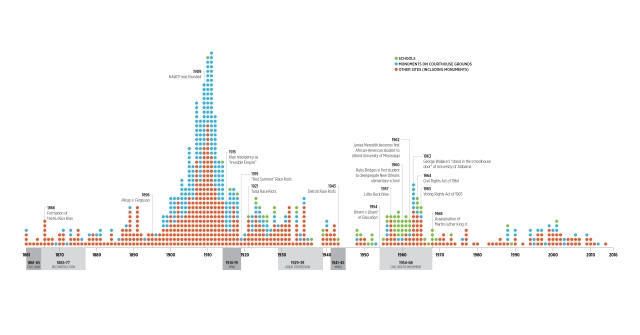 The Southern Poverty Law Center prepared this remarkable diagram, illustrating when Confederate symbols, such as statues, flags, and monuments, were erected in public places– mostly around 1910 and then again in the 1960s during the Civil Rights movement. Their full report is here. CNN has a summary here. Point being there were rather sudden and pronounced political and social motivations to put these things up in the first place. They weren’t just always there from the beginning. There are lots of parallels when it comes to symbols of control over Native Americans. Here are three:
The Southern Poverty Law Center prepared this remarkable diagram, illustrating when Confederate symbols, such as statues, flags, and monuments, were erected in public places– mostly around 1910 and then again in the 1960s during the Civil Rights movement. Their full report is here. CNN has a summary here. Point being there were rather sudden and pronounced political and social motivations to put these things up in the first place. They weren’t just always there from the beginning. There are lots of parallels when it comes to symbols of control over Native Americans. Here are three:
-

This painting from 1872, American Progress, features the woman Columbia leading ‘civilization’ while the ‘savages’ flee.
“Columbia” – a name that adorns the nation’s capitol, as well as many other cities and one of the largest rivers in North America (with, historically, the most salmon), is derived from Christopher Columbus, which seems strange since he was Italian, worked for Spain, and never set foot in the US. The term “Columbia” began to be used in the mid-1700s, when the European population on the Eastern seaboard began to pass the Native population. Nearly 250 years after Columbus lived, the American colonists were clearly claiming the continent for Europeans. The name persists nearly everywhere.
 Native mascots for universities and professional sports teams started in 1909 and really took off in the early to mid-1900s, when Natives were largely confined to reservations and no longer posed a military threat. Many Indian mascot names have since been revised.
Native mascots for universities and professional sports teams started in 1909 and really took off in the early to mid-1900s, when Natives were largely confined to reservations and no longer posed a military threat. Many Indian mascot names have since been revised.- Pocahontas, who died in 1617, was largely ignored by history for over 200 years. She was resurrected during the Indian Wars of the 1800s as a model “good Indian”. Her story was revised– she went from being a raped captive to a willing convert and wife. The recast Pocahontas appeared in children’s stories and a wide variety of product advertisements. She continues to be appropriated and marketed today.

